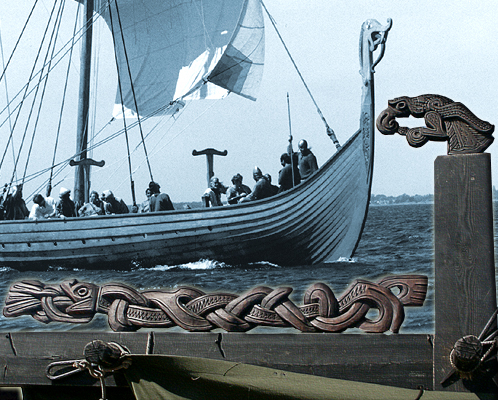| Vikingetidens skibe

| | En af de vigtigste forudsætninger for vikingernes ekspansion var deres skibe. Vikingerne blev utroligt dygtige skibskonstruktører, hvad enten det gjaldt de berømte langskibe eller de mere dybtgående lastskibe, som kaldtes knarrar. |
Forskellige skibstyper
Det var i kraft af en stor flåde, at vikingekongerne kunne herske over store områder. Da vikingetiden desværre normalt anses for at være en krigerisk periode, er det en udbredt misforståelse, at vikingeskibene udelukkende har været krigsskibe. Sådan har det givetvis ikke været. Af alle de titusindvis af vikingeskibe, som sejlede i de nordiske farvande, har kun et fåtal været krigsskibe. De øvrige skibe har sejlet langsomt, ligget dybt i vandet og været lastet med handelsvarer.
Langskibet
I den rige islandske sagalitteratur møder vi masser af oplysninger om datidens skibe. I det følgende beskrives kun de skibstyper, som omtales i den såkaldte Egil Skallagrimssons saga fra 900-tallet. Da sagaens hovedperson, Egil, var en stridslysten viking optræder ”langskibet” hyppigt i beretningen. Da islændingen Arinbjørn f.eks. besluttede sig for at drage på vikingetogt, udrustede han tre store langskibe, som kunne bære 300 mand. En anden viking, Torolv, lod et stort langskib søsætte. Han bemandede det med mere end hundrede mand, alle prægtige og svært bevæbnede folk. Selv havde Egil et langskib, som kunne rumme mindst hundrede mand.

Vikingernes skibe | 
Vikingeskib |
Snekken og Karven
Der fandtes dog også mindre langskibe. Den ovenfor omtalte Torolv har i begyndelsen af sagaen et langskib, der kunne rumme 60 mand. På det sad der et dragehoved og han udrustede det på prægtigste vis. Skibstypen ”snekke” har også hørt til krigsskibene. Da Toroly og Eyvind Lambe skulle besøge kong Harald benyttede de et skib af den type: ”De kom dertil med en tyvetoftet, velbemandet snekke, som de tidligere havde været på vikingetogt i.”
Blandt de skibstyper, der ikke var krigsskibe, møder man betegnelsen ”karve”. En karve havde, selvom den var et ret lille skib, åbenbart givet sin ejer høj status. Af sagaen fremgår det, at disse skibe har været malet på ydersiden: ” De havde en karve, som blev roet af tolv eller tretten mand ved hver ræling og de havde næsten tredive mand med sig. Dette skib havde de kapret på sommerens vikingetogt. Det var malet over vandlinien og meget smukt. Da de kom til Tore, blev de vel modtaget og blev der en tid. Karven lå overdækket på bredden foran gården.” Både skibstypens ringe størrelse og dens høje status fremgår af sagaen, når der senere berettes om Rognvald kongesøns skib. Han havde ” en seksåret karve, malet på hele fribordet. I den havde han med sig ti eller tolv mand, som altid fulgte ham. ”

Handelsskibe |
Knarren
Af handelsskibe omtales både ”lastskib”, ”skude” og ” knarr”. Et af sagaens lastskibe havde en besætning på tyve mand. En skude var bemandet med op til tredive mand og var meget hurtig at ro. Knarren var det største lastskib, som vikingetidens mennesker havde til rådighed. Den stak dybt og havde højt fribord og var derfor velegnet til at møde Nordsøens og Atlanterhavets vældige bølger. Det var ved hjælp af knarrer, at vikingerne og deres familier kunne befolke øerne i Atlanterhavet, ikke mindst fordi man kunne medbringe levende kvæg på skibene. Da Egil Skallagrimsson og hans staldbroder Kvællsulv engang skulle sejle af sted,” blev to store knarrer udrustet til færden. På begge havde de tredive våbenføre mænd og dertil kvinder og børn. ”
Krigshavnen i Foteviken
I Øresundsområdet danner Foteviken på den skånske Øresundskyst en strategisk beliggende naturhavn, antagelig for den skånske krigsflåde. I vigens munding ud mod Høllviken blev der anlagt en næsten 300 meter lang spærring af sten og træ under vandoverfladen. Kun en lille åbning i midten har gjort det muligt for et skib ad gangen at sejle igennem.
Spærringen ved mundingen af Foteviken blev fundet og delvist undersøgt i begyndelsen af 1980erne. Allerede på et håndtegnet søkort fra 1680erne er stedet afmærket med navnet ” Stiigan ”. Navnet hentyder til de mange træpæle, som her er hamret ned. En årringsdatering antyder, at anlægget kan være påbegyndt i Harald Blåtands tid og efterhånden færdiggjort. I en senere periode er sten blevet brugt til at udbygge spærringen. Vel indenfor spærringen måtte man ro skibet næsten en kilometer mod syd i den dybe rende, som løber i den ellers lavvandede vig. Til sidst måtte man runde en sandsynligvis kunstigt anlagt ø, inden man nåede frem til det havnebassin, som antageligt har ligget her. Lige ovenfor havnebassinet har kongsgården ligget sammen med et mindre kapel og landsbyen Lilla Hammar. Der har dog endnu ikke været foretaget udgravninger i dette spændende miljø fra vikingetiden.

Halör | 
Roar Ege | 
Vikingeskib med soldater |
|